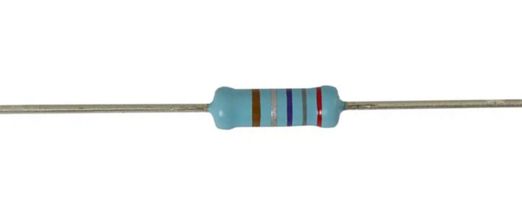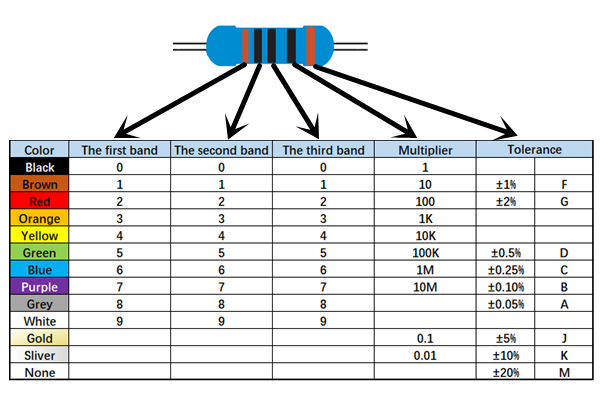Resistors with color bands are a convenient way for users to determine their resistance value directly by reading the colored bands, without needing any measuring tools. These markings are typically found on cylindrical resistors such as carbon film, metal film, metal oxide film, fuse, and wire-wound resistors. The number of color bands can vary, usually indicating four, five, or six bands that represent the resistor’s value and tolerance.

Color-coded resistors are among the most frequently used components in electronic circuits. They are marked with colored bands around the body of the resistor to indicate their resistance value. The standard units for these resistors include ohms (Ω), kilo-ohms (KΩ), and mega-ohms (MΩ). For reference, 1 MΩ equals 1000 KΩ or 1,000,000 Ω.
Most commonly, color-coded resistors come in either four-band or five-band configurations, with four-band being more widely used. In a four-band resistor, the first two bands represent the significant digits, the third band is the multiplier, and the fourth band indicates the tolerance. In a five-band resistor, the first three bands are the significant digits, the fourth is the multiplier, and the fifth represents the tolerance. Tolerance is usually shown by gold (5%), silver (10%), and brown (1%). If no band is present, it typically means a 20% tolerance, while green may occasionally be used for 0.5% tolerance.

Identifying Four-Band Resistors
A four-band resistor uses four colored bands to indicate its resistance value. From left to right, the first band is the first digit, the second band is the second digit, the third band is the multiplier, and the fourth band shows the tolerance. When it's difficult to identify the first band, checking the fourth band—usually gold or silver—can help. This method works only for four-band resistors and not for five-band ones.
Examples:
- Red, yellow, brown, gold: 24 × 10 = 240Ω, tolerance of 5%
- Green, red, yellow, silver: 52 × 10,000 = 520KΩ, tolerance of 10%
Identifying Five-Band Resistors
A five-band resistor has five colored bands, with the first three representing the significant digits, the fourth being the multiplier, and the fifth showing the tolerance. These resistors offer higher precision than four-band types.
Example: Red, red, black, black, brown: 220 × 1 = 220Ω, tolerance of 1%.
Identifying Six-Band Resistors
Some resistors have six color bands, where the first five follow the same pattern as a five-band resistor. The sixth band indicates the temperature coefficient, which tells how the resistance changes with temperature. These are less common and used mainly in high-precision applications.
Suzhou Sikor Industry Co., Ltd. , https://www.sikor-group.com
![<?echo $_SERVER['SERVER_NAME'];?>](/template/twentyseventeen/skin/images/header.jpg)